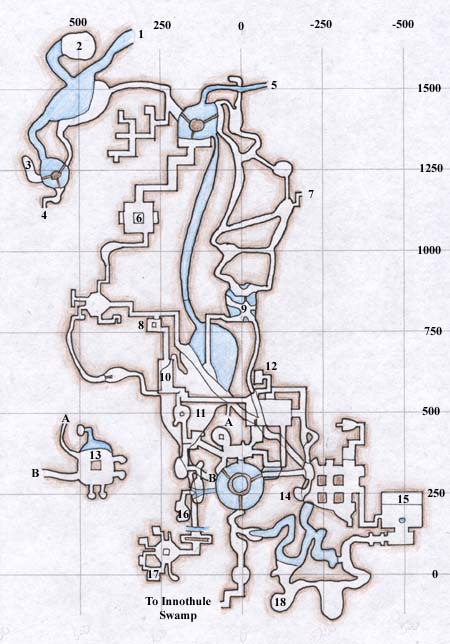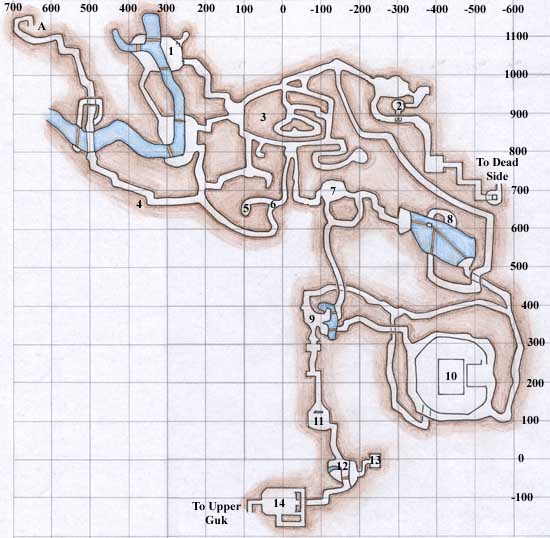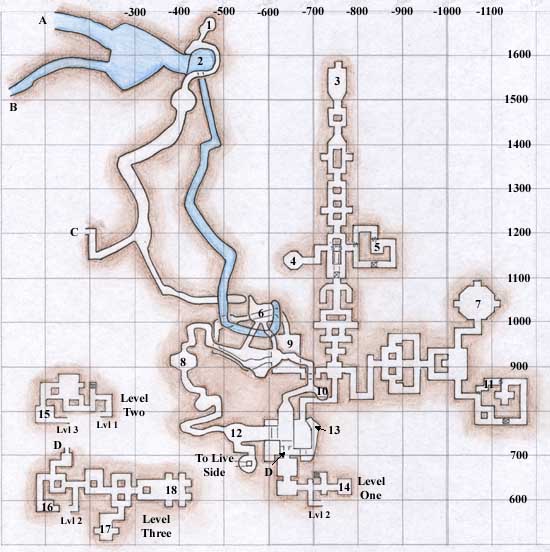Xenich
Cipher
- Joined
- Mar 21, 2013
- Messages
- 2,104
About auto maps and dungeon progression in general...
Here is a map to show the complexity of EQs dungeon design:
Upper and lower (live/dead side) Guk



This makes up two zones of Upper Guk, and Lower Guk. Lower Guk is split up based on mob type with one side being living frogs and the other side being undead frogs, but is essentially still one zone.
The Dungeon is very complex (and as you can see HUGE), very difficult to traverse as it is packed with numerous frog NPCs at every corner. To complicate issues, NPCs in EQ run away at a certain percentage of health and the Frogs all run (hop) at faster than normal run speeds. The result is that before you realize it, the frog can run away picking up adds along the way resulting in a MASSIVE train and certain death to the group. So, it is required that someone be able to snare, stun, root, etc... to avoid such an escape.
When I first did this zone, there was no in game map system and there was no out of game map system either. Muse didn't start making the maps until a bit later as he became higher level and was able to more easily map the areas.
As you can tell, it was quite the learning adventure. Knowing how to get around Guk fully was considered a prized skill. Learning Guk was a progression over a characters life time of levels and one could essentially spend their entire progression there if they chose. Upper Guk's level range was 4-25+, while Lower Guk was 30-50+. Learning the dungeon was a process of camping small chunks at a time of the area and slowly progressing through. As a monk, I was often the designated puller/scout. I would bring in the mobs to a static camp we setup and we would pull the surrounding area. As I did, I reported my findings to the group, things such as mob locations both standard and named. Roaming mobs and their intervals, empty rooms for possible safe spots, pits/traps, hidden walls and secret areas, etc... As we learned a given area, we would move in deeper.
Leveling in EQ took a VERY long time. So, by the time, a group who had spent quite a bit of time in Guk was nearing the cap of the dungeon, they knew it like the back of their hand (more so those who did the scouting and pulling). Maps as you see above were a "convenience", a helper tool, not a means for navigation for those unfamiliar with the area. If you didn't know the zone, the map would help in simpler dungeon designs, but in complex ones such as Guk where there secret walls, hidden pits that drop to other levels, etc... it had its limitations, an offline map a such would give you a basic feel, you still had to learn the dungeon by physical sight. The dungeons were too dangerous to idle too long in a non-safe spot.
Now enter some of the game mechanics. As I said, the dungeon was deadly, mobs were packed everywhere, could run faster than you and the areas were tight with turns so you couldn't see a mob (or group) often until you agro'd it. Some classes in the game had invisibility (two types, to living and undead), but how long an invis spell lasted was random. It could last anywhere from 10 seconds to 30 mins and EQ did not allow you to see your buff timers, so invis could drop at some really bad times. Add in the fact that there was also the spell "see invis" and you had big problems. Every NPC in the game used the same class system that players had. So, certain mobs could see invis, but it was not easy to see which ones because even if you noticed a given "type" of mob to be a certain class, it didn't mean they weren't buffed by another mob they passed by as they patrolled the area. So, as I said, invis was not a reliable means to slowly explore and map out a dungeon. You used invis for quick traversal, often stopping at safe spots to increase your ability to mitigate a dropped invis and the add likely to come with it.
The point is, you had to learn the zone and it was a major accomplishment to learn such. There were people who were sought after in groups because they were essentially "guides" to the zone. They knew the ins and outs, the secrets, the mob locations, etc...
This is getting back to my point. The auto-maps we see in today's games removes this basic subtle feature of play. The exploration, the danger of it, the risk and reward of exploring and finding things others dare not or were not skilled enough to achieve. With auto-map systems, the player knows where they are, where they are heading at all times, etc... (add in a radar map and it just kills this entire aspect of play) like I said, an out of game map does give a lot of info, but looking at a static map and looking at the area in game isn't that easy often, especially in a dungeon such as this.
When people talk about the "feeling" they remember in EQ, I argue it is things like this they are talking about. It is the risk and reward, the mystery and scale of such a dungeon, the progression over levels in a single area. This is what people miss and this is what "convenience" took away from the game and why people can't seem to find that "feeling" they had in EQ.
One last comment about zones being invalidated over levels. Look at this dungeon, this is what I am talking about as it concerns "striping" of content in a zone. Notice how in a single major dungeon it consists of levels from 4-50? Remember, this is one of the first dungeons from the original release where the level cap was 50. A single dungeon among 50 zones of content to explore. If you continue to layer new level caps and content within these zones as you release expansions, it can keep old content alive for a much longer time.
Here is a map to show the complexity of EQs dungeon design:
Upper and lower (live/dead side) Guk



This makes up two zones of Upper Guk, and Lower Guk. Lower Guk is split up based on mob type with one side being living frogs and the other side being undead frogs, but is essentially still one zone.
The Dungeon is very complex (and as you can see HUGE), very difficult to traverse as it is packed with numerous frog NPCs at every corner. To complicate issues, NPCs in EQ run away at a certain percentage of health and the Frogs all run (hop) at faster than normal run speeds. The result is that before you realize it, the frog can run away picking up adds along the way resulting in a MASSIVE train and certain death to the group. So, it is required that someone be able to snare, stun, root, etc... to avoid such an escape.
When I first did this zone, there was no in game map system and there was no out of game map system either. Muse didn't start making the maps until a bit later as he became higher level and was able to more easily map the areas.
As you can tell, it was quite the learning adventure. Knowing how to get around Guk fully was considered a prized skill. Learning Guk was a progression over a characters life time of levels and one could essentially spend their entire progression there if they chose. Upper Guk's level range was 4-25+, while Lower Guk was 30-50+. Learning the dungeon was a process of camping small chunks at a time of the area and slowly progressing through. As a monk, I was often the designated puller/scout. I would bring in the mobs to a static camp we setup and we would pull the surrounding area. As I did, I reported my findings to the group, things such as mob locations both standard and named. Roaming mobs and their intervals, empty rooms for possible safe spots, pits/traps, hidden walls and secret areas, etc... As we learned a given area, we would move in deeper.
Leveling in EQ took a VERY long time. So, by the time, a group who had spent quite a bit of time in Guk was nearing the cap of the dungeon, they knew it like the back of their hand (more so those who did the scouting and pulling). Maps as you see above were a "convenience", a helper tool, not a means for navigation for those unfamiliar with the area. If you didn't know the zone, the map would help in simpler dungeon designs, but in complex ones such as Guk where there secret walls, hidden pits that drop to other levels, etc... it had its limitations, an offline map a such would give you a basic feel, you still had to learn the dungeon by physical sight. The dungeons were too dangerous to idle too long in a non-safe spot.
Now enter some of the game mechanics. As I said, the dungeon was deadly, mobs were packed everywhere, could run faster than you and the areas were tight with turns so you couldn't see a mob (or group) often until you agro'd it. Some classes in the game had invisibility (two types, to living and undead), but how long an invis spell lasted was random. It could last anywhere from 10 seconds to 30 mins and EQ did not allow you to see your buff timers, so invis could drop at some really bad times. Add in the fact that there was also the spell "see invis" and you had big problems. Every NPC in the game used the same class system that players had. So, certain mobs could see invis, but it was not easy to see which ones because even if you noticed a given "type" of mob to be a certain class, it didn't mean they weren't buffed by another mob they passed by as they patrolled the area. So, as I said, invis was not a reliable means to slowly explore and map out a dungeon. You used invis for quick traversal, often stopping at safe spots to increase your ability to mitigate a dropped invis and the add likely to come with it.
The point is, you had to learn the zone and it was a major accomplishment to learn such. There were people who were sought after in groups because they were essentially "guides" to the zone. They knew the ins and outs, the secrets, the mob locations, etc...
This is getting back to my point. The auto-maps we see in today's games removes this basic subtle feature of play. The exploration, the danger of it, the risk and reward of exploring and finding things others dare not or were not skilled enough to achieve. With auto-map systems, the player knows where they are, where they are heading at all times, etc... (add in a radar map and it just kills this entire aspect of play) like I said, an out of game map does give a lot of info, but looking at a static map and looking at the area in game isn't that easy often, especially in a dungeon such as this.
When people talk about the "feeling" they remember in EQ, I argue it is things like this they are talking about. It is the risk and reward, the mystery and scale of such a dungeon, the progression over levels in a single area. This is what people miss and this is what "convenience" took away from the game and why people can't seem to find that "feeling" they had in EQ.
One last comment about zones being invalidated over levels. Look at this dungeon, this is what I am talking about as it concerns "striping" of content in a zone. Notice how in a single major dungeon it consists of levels from 4-50? Remember, this is one of the first dungeons from the original release where the level cap was 50. A single dungeon among 50 zones of content to explore. If you continue to layer new level caps and content within these zones as you release expansions, it can keep old content alive for a much longer time.


















